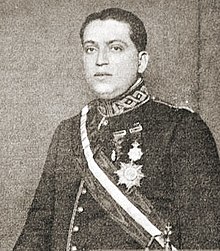José Calvo Sotelo
José Calvo Sotelo (born May 6, 1893 in Tui , Pontevedra province , † July 13, 1936 in Madrid ) was a Spanish politician and minister .
Political activity
After training as a public prosecutor and various journalistic activities, he was appointed State Secretary to the Government Ministry ( Ministerio de Gobernación ) by Miguel Primo de Rivera in order to develop a statute of autonomy for the regions, municipalities and counties in administrative and social terms.
Subsequently, Calvo Sotelo became Minister of Finance , which he remained until 1930. During this time he managed to increase the state's income significantly. Among other things, he created the state oil monopoly ( CAMPSA ) and fought tax evasion, especially among the upper classes, but failed because of high inflation and therefore resigned in 1930.
In the second Spanish republic , Calvo Sotelo was forced into exile because of his collaboration with the dictatorship of Primo de Rivera , first to Lisbon and later to Paris . Although he won a parliamentary mandate from exile for the legislature from 1931 to 1933 as well as for the following period, he was unable to exercise it.
In 1934 he was given amnesty after the right-wing electoral victory and subsequently became active in the Renovación Española (German: Spanish Renewal ), a monarchist-authoritarian party. A democrat in his youth, Calvo Sotelo had turned into one of the most important figures of the Spanish right during his forced exile.
In 1934 he also founded the Bloque Nacional , a loose amalgamation of the two monarchist currents (Alfonsinos and Carlistas ) and various regional right-wing groups, of which he became chairman.
After the election victory of the left Frente Popular (German Popular Front ), Calvo Sotelo became a leading figure in the right-wing opposition. The government, victims of both right and left extremists, could not guarantee public order, which Calvo had always called for. There were mass strikes, street fights and a series of assassinations.
The assassination attempt on July 13, 1936
At the height of the unrest, Calvo Sotelo was murdered on July 13th by members of the Guardia de Asalto and the Guardia Civil , which historians Ian Gibson , Paul Preston and Gabriel Jackson believe was an act of revenge for an attack by the extreme right (Falangists or Carlist ) was intended for a republican lieutenant in the Guardia de Asalto. Conservative historian Bullón de Mendoza has investigated the case, drawing on files from the trial in which former Franco opponents had to justify the murder immediately after Franco's victory at the time of the political cleansing waves. Bullón sees signs that the murder could have been planned for some time and that the attack on Castillo was probably only used as a pretext: The head of the national security directorate, José Alonso Mallol, ordered on June 29, 14 days before the attack to replace Calvo Sotelo's escort in order to better monitor him. A member of the new escort, Serrano de la Parte, testified in court that he was charged with feigning resistance in a central location in the event of an attack on Calvo Sotelo and not resisting in the event of an attack in a remote location or Calvo kill yourself. Some of Calvo's murderers came from the escort of MPs from the Spanish Left, who hid them after the attack and before the outbreak of civil war. Luis Cuenca, a friend of Castillo's, and another assassin found shelter with the PSOE MP Margarita Nelken . Also Indalecio Prieto and another PSOE deputy, Julián Zugazagoitia should have known about the perpetrators of Cuenca, but exposed the fact. The publicly expressed joy of the revolutionary Dolores Ibárruri over the assassination became known.

According to some, this attack gave the military the support of the conservative population, which they actually experienced four days later, at the beginning of the Spanish Civil War . His death also induced the Carlist to support the coup with their paramilitary groups.
During the Franco dictatorship, Calvo was nicknamed "the first martyr" (Protomártir). Spanish right-wing extremists still consider Calvo Sotelo a “martyr” today. He is still present in public today through a monument erected in 1960 (during Franquism ) in the Plaza de Castilla (near the towers of today's Puerta de Europa ) in Madrid and through several streets throughout the country that are named after him. A gunboat of the Spanish Navy also bore his name.
His nephew Leopoldo Calvo-Sotelo was Prime Minister of Spain from February 1981 to December 1982 .
swell
- ↑ See Bullón de Mendoza, Calvo Sotelo , p 661ff .; see. Juan-Simeón Vidarte: Todos fuimos culpables , Volume 1, pp. 213-217; Indalecio Prieto: Convulsiones de España , Volume 1, p. 162.
literature
- Alfonso Bullón de Mendoza: José Calvo Sotelo. Ariel Ed., Barcelona 2004, ISBN 84-344-6718-6 .
Web links
- Newspaper article about José Calvo Sotelo in the 20th century press kit of the ZBW - Leibniz Information Center for Economics .
| personal data | |
|---|---|
| SURNAME | Calvo Sotelo, José |
| BRIEF DESCRIPTION | Spanish monarchist politician |
| DATE OF BIRTH | May 6, 1893 |
| PLACE OF BIRTH | Tui , Pontevedra Province |
| DATE OF DEATH | July 13, 1936 |
| Place of death | Madrid |
